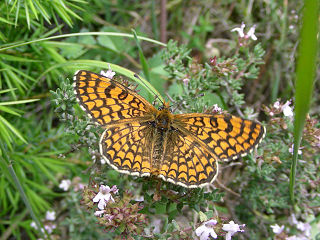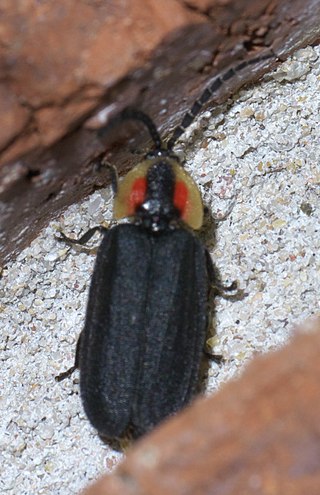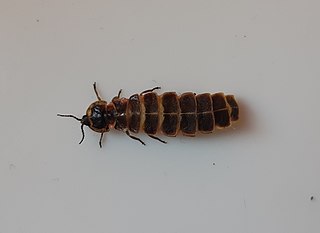
The Lampyridae are a family of elateroid beetles with more than 2,000 described species, many of which are light-emitting. They are soft-bodied beetles commonly called fireflies, lightning bugs, or glowworms for their conspicuous production of light, mainly during twilight, to attract mates. Light production in the Lampyridae is thought to have originated as a warning signal that the larvae were distasteful. This ability to create light was then co-opted as a mating signal and, in a further development, adult female fireflies of the genus Photuris mimic the flash pattern of the Photinus beetle in order to trap their males as prey.
Glowworm or glow-worm is the common name for various groups of insect larvae and adult larviform females that glow through bioluminescence. They include the European common glow-worm and other members of the Lampyridae, but bioluminescence also occurs in the families Elateridae, Phengodidae and Rhagophthalmidae among beetles; as well as members of the genera Arachnocampa, Keroplatus and Orfelia among keroplatid fungus gnats.

Photinus pyralis, also known by the common names the common eastern firefly or big dipper firefly, and sometimes called a "lightning bug", is a species of flying beetle. An organ on its abdomen is responsible for its light production. It is the most common species of firefly in North America, and is typically found east of the Rocky Mountains. Photinus fireflies are often confused with fireflies of the similar-sounding genus, Photuris, which are also found in North America.

The rover fireflies (Photinus) are a genus of fireflies. They are the type genus of tribe Photinini in subfamily Lampyrinae. This genus contains, for example, the common eastern firefly, the most common species of firefly in North America.

The Provençal fritillary is a butterfly in the family Nymphalidae. It is found in south-western Europe and North Africa. The range extends from the Iberian Peninsula to southern France and the Alps in Switzerland and Italy. It is also found in the Atlas Mountains.

Photinus carolinus, commonly known as the Smokies synchronous firefly, is a species of rover firefly whose mating displays of synchronous flashing have fascinated both scientists and tourists. As individual females synchronize with males nearby, waves of alternating bright light and darkness seem to travel across the landscape. Firefly displays typically occur in early June near Elkmont, Tennessee, in the Great Smoky Mountains National Park, near Gatlinburg. The species can be found in isolated pockets of the Appalachian Mountains in the eastern United States.

Phosphaenus hemipterus, the short-winged firefly or lesser glow worm, is a beetle in the monotypic genus Phosphaenus and the family Lampyridae. It is found in the Mediterranean, in Central Europe, west to the Atlantic Ocean and north to the edge of Scandinavia and in England. In North America, the species has been introduced. It inhabits meadows, floodplains, forest edges, and dry slopes, but also parks and gardens. In Britain, this species is fairly rare compared to the common glow-worm.

Nipponoluciola cruciata, known as "genji-botaru" (ゲンジボタル) in Japanese, is a species of firefly found in Japan. Its habitat is small ditches and streams, and its larvae are aquatic. It was formerly known as Luciola cruciata but was revised taxonomically in 2022.
Photinus consanguineus, or double cousin firefly, is a species of firefly in the genus Photinus. It is found in eastern North America.
Photinus macdermotti, or Father Mac's firefly or Mr. Mac, is a species of firefly in the family Lampyridae. It is found in North America.
Photinus brimleyi, or sidewinder firefly, is a species of firefly in the Photinus genus. It is found in the southeastern United States.

Lucidota atra, the black firefly or woodland lucy, is a diurnal species of firefly — a member of the Lampyridae family of beetles.
Photinus cookii, or Cook's firefly is a species of day-active firefly in the beetle family Lampyridae. It is found in North America in the Eastern USA, including Florida and Texas.
Photinus concisus is a species of firefly in the beetle family Lampyridae. It is found in Kerrville, Texas. It the species most closely related to Photinus pyralis.

Photinus consimilis, or cattail flash-train firefly, is a species of firefly in the beetle family Lampyridae. It is found in eastern North America.

Photinus indictus, or silent firefly, is a species of firefly in the beetle family Lampyridae. It is a diurnal firefly, active during the day rather than at night, with no lanterns. It is found in eastern North America.
Photinus tenuicinctus, or thinly-girdled firefly or Ozark spark, is a species of firefly in the beetle family Lampyridae. It is found in the Ozarks in Arkansas and Oklahoma.

Lampyris iberica, the Iberian firefly, is a species of firefly. The species is endemic of the Iberian Peninsula and Southern France.

Photuris lucicrescens, the long crescendo Photuris, July comet, big scary, or big Lucy, is a species of beetle in the Lampyridae family. It is found in the eastern United States.
Photuris hebes, commonly known as heebie-jeebies or the slow-hitch firefly, is a species of beetle in the Lampyridae family. It is found in the eastern United States.


















